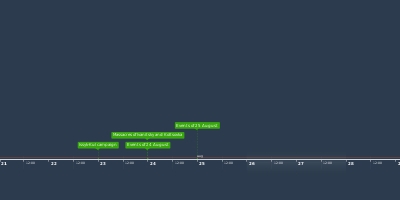End of the Sinai campaign (13 фев 1917 г. – 21 фев 1917 г.)
Описание:
Two mounted columns set out from the Suez Canal on 13 February 1917. Northern Column consisting of 420 troopers in the 11th Light Horse Regiment, one Royal Engineer officer and four other ranks, one Royal Army Medical Corps (RAMC) officer with a detachment from 124th Field Ambulance Str. 26, one Royal Flying Corps (RFC) officer and two other ranks and two wireless pack stations, rode out from Serapeum near Ismailia in the centre of the Canal. Lieutenant Colonel A. W. Jennings Bramly (an Egyptian Government officer with knowledge of the country), Captain F. D. Stirling (General Staff GHQ), and Lieutenant A. H. Stuart (Intelligence Branch, General Staff), along with one aircraft observer and two mechanics to choose advanced landing ground and supervise the transportation of petrol, oil and spare parts accompanied the force. By 14 February the column concentrated at Zogna where a supply dump had been established. Meanwhile, Southern Column consisting of the 6th Mounted Brigade headquarters, with yeomanry from this brigade, and the Indian 58th Rifles rode out from Suez at the southern end of the Suez Canal, via Heniak, Ayun Sudr, the Mitla Pass and the Darb el Haj towards Nekhl. Three aircraft from No. 1 Squadron based at El Arish worked from the aerodrome of No. 57 Reserve Squadron at Ismailia during the raid, were to report daily on the progress of the two columns, drop messages from headquarters and scout ahead. while a yeomanry force marched from Suez via the Mitla Pass and the Darb el Haj.[4][5][7][8]Northern Column advanced to Bir el Giddi on 15 February where a detachment of 60 rifles from No. 9 Company, Imperial Camel Corps joined the column from Shallufa. Here an officer's patrol commanded by Lieutenant Farlow reported the Themada wells silted up and no water was available there. Instead of the proposed three nights, this information meant only two nights could be spent at an advanced base to be established near Nekhl.[9] As a result, a group was sent ahead by Northern Column to Themada to do their best to obtain a water supply, while that column followed from Bir el Giddi in cold and wet weather, after giving the horses time to get a good drink. On arrival at Themada four wells had been dug to an average of 8 feet (2.4 m), each of the wells had 4 feet (1.2 m) of water which was maintained during pumping water for the whole regiment.[10]
Major Bassett commanding 2nd Battalion (British), Imperial Camel Corps, marched from Magdhaba on 17 February to surround Bir el Hassana, where at dawn the next morning they attacked the Ottoman Army garrison consisting of three officers and 19 other ranks, reinforced by armed Bedouin. During the attack a severely wounded soldier was flown back to El Arish by aircraft. After the surrender of Bir el Hassana, Bassett's force remained in position to capture any Ottoman force withdrawing back from Nekhl towards Bir el Hassana.
On 17 February Northern Column sent an officers' patrol commanded by Lieutenant F. C. Farlow to select a site for an advanced base and to reconnoitre the Thilwetl el Thamamat Pass, 4 miles (6.4 km) north of Nekhl. The patrol reported at 15:30 that three shots had been fired from high ground on the Bir el Hassana road shortly after 13:00 by a Bedouin who subsequently withdrew on his camel towards Nekhl. By 16:00 Northern Column reached 7 miles (11 km) north of Nekhl where an advanced base was established.
At 04:00 on 18 February, the main force of Northern Column left their advanced base and entered Nekhl at 06:00 when two more prisoners and abandoned arms, ammunition and stores were captured. Patrols sent out eastwards up to a distance of 15 miles (24 km) failed to find any hostile soldiers. Heliographic communication was established by Northern Column with Southern Column at 08:30; that column reaching Nekhl at 09:05. After a thorough search of the town and the demolishing of a captured field gun, Southern Column commenced their return journey at 10:30. Later another two Arab were found hiding in the hills along with one Ottoman soldiers who was killed while trying to escape.
General Archibald Murray, commander of the Egyptian Expeditionary Force, ordered attacks against both Nekhl and Bir el Hassana, which lay 40 miles (64 km) north of Nekhl, between the Gebel Helal and the Gebel Yelleg.[1][2] Three columns of cavalry and camelry set out with the goal of all attacking on 18 February. One column set out from Serapeaum (possibly the vicinity of Ismailia), and another from Suez on 13 February 1917 to converge on Nekhl.[3] Major J.R. Bassett, commanding 2nd Battalion (British), Imperial Camel Corps, together with the Hong Kong and Singapore (Mountain) Battery, marched from El Arish, via Magdhaba.[4]
This column reached Lahfan on the 16th,[3] and on the 17th advanced from Magdhaba. At dawn the next morning they surrounded the Ottoman Army garrison at Bir el Hassana, which consisted of three officers and 19 other ranks, reinforced by armed Bedouin. The Ottoman troops surrendered, but the Bedouin fired on the British, shattering Lance Corporal McGregor's ankle. One of the Turks who surrendered was Nur Effendi, who had commanded the garrison at the unsuccessful British attack on Maghara on 15 October 1916. The troops searched Bir el Hassana and found 21 rifles, a few camels, and 2100 rounds of ammunition.[3]
After the surrender of Bir el Hassana, Bassett's force remained in position to capture any Ottoman force withdrawing back from Nekhl towards Bir el Hassana.
Добавлено на ленту времени:
Дата:
13 фев 1917 г.
21 фев 1917 г.
~ 8 days
